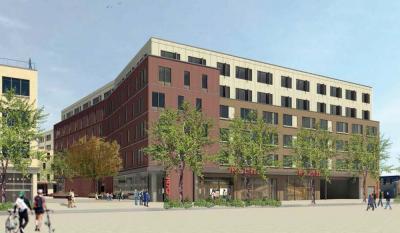October 1, 2015
 Updated sketch from RODE Architects shows a section of the revamped DOT Block project.
Updated sketch from RODE Architects shows a section of the revamped DOT Block project.
The DOT Block development is proceeding without a section at Dorchester Avenue and Hancock Street that was in the original proposal, project organizers said at a Boston Redevelopment Authority-hosted meeting Monday night. Developers, though, remain hopeful that the parcel will be re-incorporated into the plans at a future date.
Eric Robinson of RODE Architects and Catherine O’Neill, representing the development team, briefed a full room at the Boys and Girls Clubs of Dorchester’s Paul R. McLaughlin Youth Center on the latest iteration of the sprawling project.
The development has expanded and contracted since its inception, hitting a bump in the road last month when a sales agreement expired on three properties near one corner of the site. This ratcheted down the overall design to more closely align with the original proposal. After a supplemental filing to the BRA on Sept. 15, the public comment period for the new design was extended until Oct. 9.
“The project is vastly different than the last time we saw it,” said City Councillor Frank Baker, who was at the meeting. “We’re kind of back toward the beginning again.”
As he has from the start, Baker spoke on the benefits of an active street life in combating concerns over drug use and prostitution along what is now a largely desolate stretch of Dorchester Avenue, particularly after dark.
The development team fielded a host of questions from residents grappling with the project as a whole and with the most recent adjustments. The scope of the development is estimated at 385,000 square feet, not including a five-story parking structure. It is arranged in a mix of three exclusively residential buildings and two buildings with a combination of ground-floor retail and higher-floor residential units, interspersed with broad pedestrian walkways.
The buildings facing Dorchester Avenue have been combined to better utilize the smaller amount of space without the original corner. DOT Block’s interior remains largely unchanged from earlier versions, Robinson said. “We are refocusing our efforts on the core of the project,” he said. “Our hope is that the rest will come along,” he added, in reference to the three corner lots.
One resident asked what changes had resulted from community input. Among such changes, developers said, were the removal of a Hancock Street entrance to the development, a townhouse design giving way to a more solid appearance, height adjustments, and the introduction of building setbacks.
Organizers said that local input has been incorporated into the plans throughout the process. “We have worked with the community from the beginning,” O’Neill added.
Concerns continue to be raised regarding traffic, particularly over a potential increase during peak hours near the heavily trafficked Freeport Street intersection.
Lee Adelson, president of Fields Corner Main Streets, said that navigating the intersection at rush hour is “difficult enough.”
A representative from Howard Stein Hudson, a traffic consulting firm, broke down the anticipated impact on local traffic. Due to the entrance locations and traffic flows, he said, few cars are expected to approach DOT Block from the south. At peak hours, an estimated 152 cars would move north toward the development, and that direction of approach would account for only 15 percent of the trips associated with the project.
The connection between Hancock and Pleasant street is expected to be a single-lane roundabout, which will keep traffic at under 25 miles per hour, the representative said. However, there are three proposals on how to reconfigure that intersection, including traffic signals being considered by the Boston Transportation Department.
Adelson said he was worried about increased congestion around nearby businesses, but added, “I’m glad to see people see the value of investing in Dorchester.”
In other meeting matters:
The project’s retail space has been downsized from approximately 73,000 square feet to about 40,500 square feet. This part of the plan has undergone the most dramatic adjustment because much of it will no longer abut the street.
• Mimi Ramos, whose mother lives on High Street, was in attendance on behalf of New England United for Justice. She and other attendees said they were worried about the limited, if any, outreach to the nearby Haitian and Cape Verdean populations in their native languages.
• The broader economic impact of the projects, which is held to a 15 percent rate of affordable housing for the 378 units, was a point of some contention. A long-standing fear of residents is that they will eventually be priced out of their neighborhoods by new facilities and higher-cost condos and apartments nearby. Ramos said she wants the developers to take care so that they don’t “end up displacing folks who can’t afford to live here.”


